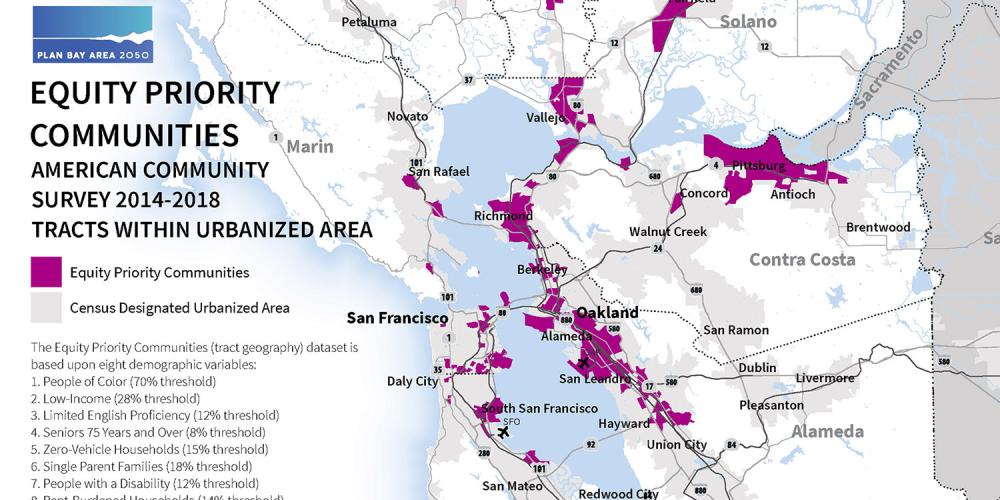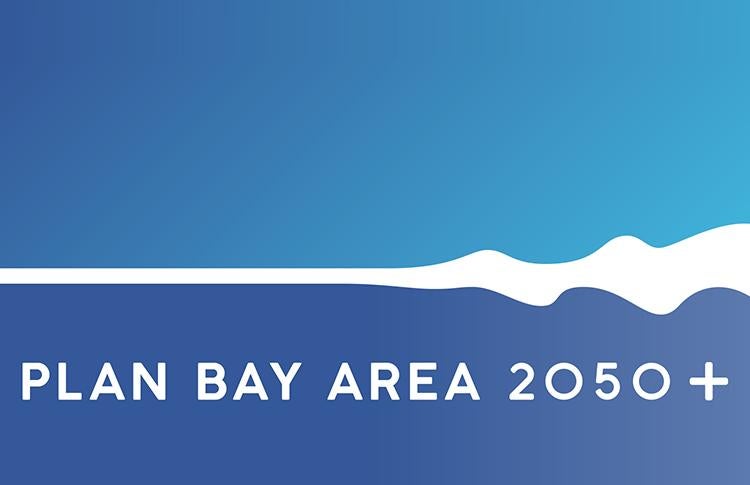
Equity Priority Communities
View and provide feedback on the draft update to the geographies of the Bay Area’s Equity Priority Communities.
What are Equity Priority Communities?
Formerly called “Communities of Concern,” Equity Priority Communities are census tracts that have a significant concentration of underserved populations, such as households with low incomes and people of color. A combination of additional factors helps define these areas.
Learn more about the demographic factors used to define Equity Priority Communities.
Since 2001, ABAG has been using data from the American Community Survey to identify communities (census tracts) that may have historically faced disadvantage and underinvestment due to their background or socioeconomic status. ABAG has continually made updates to the framework definition — and the data are updated every four years — as part of the updates to Plan Bay Area.
The Equity Priority Communities framework helps ABAG make decisions on investments that meaningfully reverse the disparities in access to transportation, housing and other community services.
Work is ongoing, and guided by ABAG’s Equity Platform.
How Does ABAG Use the Equity Priority Communities Framework?
By directing funding towards communities that need more assistance, ABAG can help ensure that historically underserved communities have equitable access to housing and transportation that is within reach of jobs, services and amenities.
The Equity Priority Communities framework has real-world impacts on how ABAG works and makes decisions. This framework is used by ABAG to make decisions about:
- Planning, including Plan Bay Area, the Transportation Improvement Program and equity analyses
- Investment of funds, including the Active Transportation Program, OBAG Grants, Community-Based Transportation Planning Grants and the Lifeline Transportation Program
- Engagement with the community
The Equity Priority Communities framework is also used beyond ABAG, by city and county agencies, in decision-making on the local level.
Equitable Access
Equitable access to affordable transportation and housing are central goals of Plan Bay Area 2050.
Equity Priority Communities Map
See the Equity Priority Communities Map from Plan Bay Area 2050.
Equity Priority Communities Data Layer
View and download the Plan Bay Area 2050 Equity Priority Communities data layer map.
What's In a Name?
ABAG heard from Bay Area residents that “Communities of Concern” no longer felt like a representative term. They wanted something empowering and uplifting — a forward-looking phrase that represents positive changes being made in the future.
After extensive discussion with community-based organizations, MTC’s Policy Advisory Council Equity & Access Subcommittee and the Regional Equity Working Group, the new name, “Equity Priority Communities,” was adopted at the Joint MTC Planning Committee with the ABAG Administrative Committee on May 14, 2021.
Priority in Funding Programs
ABAG’s partner agency, the Metropolitan Transportation Commission (MTC), explicitly uses the Equity Priority Communities framework in decision-making to award project funding.
Active Transportation Program
The Active Transportation Program uses state and federal funds to support programs that make walking and biking better travel options for Bay Area residents. MTC prioritizes projects benefiting EPCs through project scoring criteria and application evaluation process.
Mobility Hubs Pilot Program
The Mobility Hubs Pilot Program is working to advance and implement mobility hubs around the Bay Area. As a part of the guideline development and call for projects, MTC published a list of priority locations for mobility hubs. 24% of these priority locations use EPC criteria to be defined as Equity Hubs.
Innovative Deployments to Enhance Arterials - Shared Automated Vehicles (IDEA SAV)
This funding and technical assistance program will support innovative shared automated vehicle service for people living in Equity Priority Communities. Eligible projects under the IDEA SAV program will provide services and solutions that respond to the needs of EPCs.
Affordable Housing and Sustainable Communities Program
The California Affordable Housing and Sustainable Communities program funds affordable housing projects that are paired with sustainable transportation improvements. MTC uses the EPC framework to help decide which project applications to support.
Lifeline Transportation Program
The Lifeline Transportation Program funds projects that serve residents with low-incomes and low-income areas identified as an Equity Priority Communities. Projects are required: to be identified as a community priority, to demonstrate coordinated outreach within the community and to define measurable outcomes.
Safe & Seamless Mobility Quick-Strike Program
The Safe and Seamless Mobility Quick-Strike program was a one-time, competitive grant program as part of the One Bay Area Grant program (OBAG 2). Funding was available to support local and regional projects that could be implemented quickly to benefit communities responding and adapting to Covid-19. MTC prioritized projects benefiting EPCs through application scoring criteria and project evaluation process.
Community Based Transportation Plans
MTC prioritizes funding for Community Based Transportation Plans in low-income communities around the region. The plans aim to improve access and mobility for all trips, and work with residents and community organizations to make recommendations that can improve communities.


